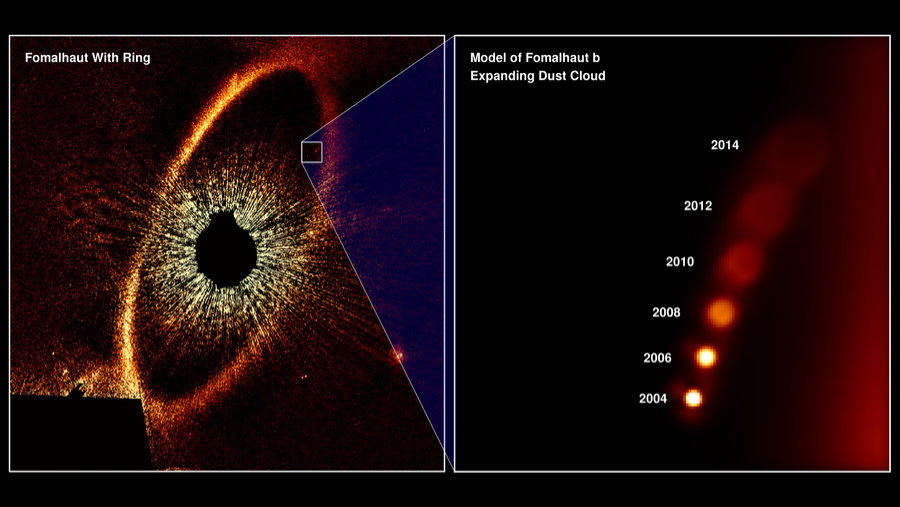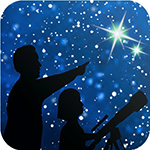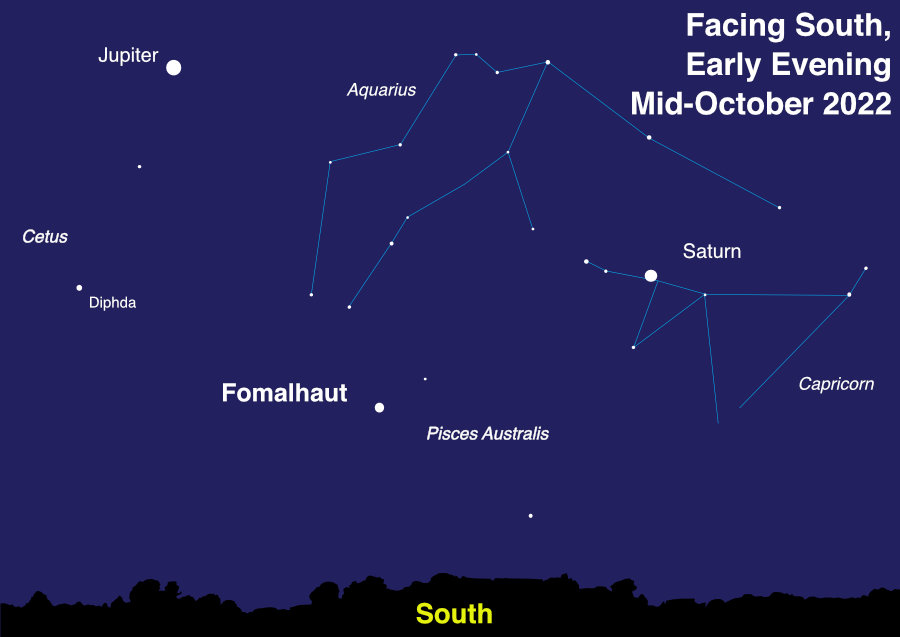Fall evenings bring a prominent visitor to southern skies for Northern Hemisphere observers: the bright star Fomalhaut! Sometimes called “The Autumn Star,” Fomalhaut appears unusually distant from other bright stars in its section of sky, leading to its other nickname: “The Loneliest Star.” Since this star appears so low and lonely over the horizon for many observers, is so bright, and often wildly twinkles from atmospheric turbulence, Fomalhaut’s brief but bright seasonal appearance often inspires a few startled UFO reports. While definitely out of this world – Fomalhaut is about 25 light years distant from us – it has been extensively studied and is a fascinating, and very identified, stellar object.
Fomalhaut appears solitary, but it does in fact have company. Fomalhaut’s entourage includes two stellar companions, both of which keep their distance but are still gravitationally bound. Fomalhaut B (aka TW Piscis Austrini, not to be confused with former planetary candidate Fomalhaut b*), is an orange dwarf star almost a light year distant from its parent star (Fomalhaut A), and Fomalhaut C (aka LP 876-10), a red dwarf star located a little over 3 light years from Fomalhaut A! Surprisingly far from its parent star – even from our view on Earth, Fomalhaut C lies in the constellation Aquarius, while Fomalhaut A and B lie in Piscis Australis, another constellation! – studies of Fomalhaut C confirm it as the third stellar member of the Fomalhaut system, its immense distance still within Fomalhaut A’s gravitational influence. So, while not truly “lonely,” Fomalhaut A’s companions do keep their distance.
Fomalhaut’s most famous feature is a massive and complex disc of debris spanning many billions of miles in diameter. This disc was first detected by NASA’s IRAS space telescope in the 1980s, and first imaged in visible light by Hubble in 2004. Studies by additional advanced telescopes, based both on Earth’s surface and in space, show the debris around Fomalhaut to be differentiated into several “rings” or “belts” of different sizes and types of materials. Complicating matters further, the disc is not centered on the star itself, but on a point approximately 1.4 billion miles away, or half a billion miles further from Fomalhaut than Saturn is from our own Sun! In the mid-2000s a candidate planetary body was imaged by Hubble and named Fomalhaut b. However, Fomalhaut b was observed to slowly fade over multiple years of observations, and its trajectory appeared to take it out of the system, which is curious behavior for a planet. Scientists now suspect that Hubble observed the shattered debris of a recent violent collision between two 125-mile wide bodies, their impact driving the remains of the now decidedly non-planetary Fomalhaut b out of the system! Interestingly enough, Fomalhaut A isn’t the only star in its system to host a dusty disc; Fomalhaut C also hosts a disc, detected by the Herschel Space Observatory in 2013. Despite their distance, the two stars may be exchanging material between their discs – including comets! Their co-mingling may help to explain the elliptical nature of both of the stars’ debris discs. The odd one out, Fomalhaut B does not possess a debris disc of its own, but may host at least one suspected planet.
While Hubble imaged the infamous “imposter planet” of Fomalhaut b, very few planets have been directly imaged by powerful telescopes, but NASA’s James Webb Space Telescope will soon change that. In fact, Webb will be imaging Fomalhaut and its famous disc in the near future, and its tremendous power is sure to tease out more amazing discoveries from its dusty grains. You can learn about the latest discoveries from Webb and NASA’s other amazing missions at nasa.gov.
*Astronomers use capital letters to label companion stars, while lowercase letters are used to label planets.
Sky map of the southern facing sky for mid-latitude Northern Hemisphere observers. With Fomalhaut lying so low for many observers, its fellow member stars in the constellation Piscis Australis won’t be easily visible for many without aid due to a combination of light pollution and atmospheric extinction (thick air dimming the light from the stars). Fomalhaut is by far the brightest star in its constellation, and is one of the brightest stars in the night sky. While the dim constellations of Aquarius and Capricorn may also not be visible to many without aid, they are outlined here. While known as the “Loneliest Star,” you can see that Fomalhaut has two relatively close and bright visitors this year: Jupiter and Saturn!
Illustration created with assistance from Stellarium

This diagram simulates what astronomers studying the Hubble Space Telescope observations, taken over several years, consider evidence for the first-ever detection of a titanic planetary collision in another star system. The color-tinted Hubble image on the left is of a vast ring of icy debris encircling the star Fomalhaut, located 25 light-years away. The star is so brilliant that a black occulting disk is used to block out its glare so that the dust ring can be photographed. In 2008, astronomers saw what they thought was the first direct image of a planet orbiting far from the star. However, by 2014, the planet candidate faded below Hubble’s detection. The best interpretation is that the object wasn’t ever a fully formed planet at all, but an expanding cloud of dust from a collision between two minor bodies, each about 125 miles across. The diagram at the right is based on simulation of the expanding and fading cloud. The cloud, made of very fine dust particles, is estimated to be 100 million miles across. Smashups like this are estimated to happen around Fomalhaut once every 200,000 years. Therefore, Hubble was looking at the right place at the right time to capture this transient event.
The magnificent and complex dust disc of the Fomalhaut system (left) with the path and dissolution of former planetary candidate Fomalhaut b displayed in detail (right).
Image credits: NASA, ESA, and A. Gáspár and G. Rieke (University of Arizona) Source: https://www.nasa.gov/feature/goddard/2020/exoplanet-apparently-disappears-in-latest-hubble-observations
This article is distributed by NASA’s Night Sky Network (NSN). The NSN program supports astronomy clubs across the USA dedicated to astronomy outreach. Visit nightsky.jpl.nasa.gov to find local clubs, events, and more!


